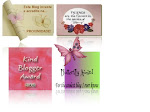Jewelry Design Ideas - How You Can Wow Them With More Color By Christine Gierer
Imagine injecting your sterling silver with blue, red, or chartreuse. I'm not talking about beads or gemstones (although I looove those too).
Here's a pop quiz: What materials can you bond, glue, or drip onto metal to add colour?
I can think of a few intriguing but common materials that you can experiment with. Can you guess what they are?
The first is...
If you can mix glue with a stick, you can use this low-tech material in your work. This relatively inexpensive medium can produce maximum results.
Epoxy is a 2 part mixture: a resin, and a hardener. Once they're mixed, it's only a matter of time it becomes a hard, durable, super glossy clear plastic substance that can be drilled, glued and sanded. It's the equivalent of 50 coats of varnish and dries to a mirror finish.
Where does the colour come in? Here's the really fantastic part - colour it with acrylic paint, gouache, jello powder, makeup powder, spices from your kitchen, or anything else you can think of.
Try layering it, drip it into etched or stamped depressions on sterling or copper sheet, and pour it into bezels. You can even try dipping things into it. Just keep in mind that epoxy is a glue, so somehow suspend any dipped work while waiting for it to cure. You don't want to bond it to anything!
You can buy two-part epoxy from the hardware store in little 2-sided syringes, and from craft and hobby suppliers in larger 2 bottle kits. You might find the larger quantity kits in some hardware stores too.
Things to know about epoxy:
- It cures up fast. Hardware store epoxy usually comes in the 5 and 11 minute varieties, and other epoxies are quick too. Make sure you factor in working time, and only mix up as much as you can use in the 5 or 10 minutes.
- Don't mix it with, or on, anything you ever want to use again. I like to mix up mine on a scrap piece of paper with a popsicle stick.
- Don't inhale it or touch it with your bare skin before it cures. It's nasty for your health. Always take proper precautions when working with chemicals.
The second material is...
What common craft material comes in every colour of the rainbow, translucent and opaque, liquid and solid, is moldable, and can be hardened in a regular oven?
Polymer clay of course! Polymer clay is made of PVC (polyvinyl chloride) and goes under various brandnames, including FIMO, Sculpey, and Friendly Clay. In case you were wondering, polymer clay usually has no actual "clay" in it.
Polymer clay can be used for more than sculting beads and pendants. Try gluing tiny pieces onto cut metal sheet components to make mosaics. Fill slices of sterling tubing with clay. Experiment with the liquid clays and coloured powders on the market.
Things to know about polymer clay:
- Each manufacturer makes its clay differently and each brand has slightly different qualities and baking temperatures so always read the instructions.
- Polymer clay needs to be "conditioned" before you can work with it. You can condition clay by kneading it with your hands, or running it through a dedicated food processor. Some people like to sit on it for awhile (in a baggie of course! )to warm it before kneading.
- Use dedicated tools with your polymer clay. You don't want to use your polymer clay rolling pin to make cookies with later.
Important notes: Do not attempt to use any of these materials without understanding what you need to do to protect your health and your surroundings. Don't inhale fumes, contaminate your household utensils, or accidentally melt, burn, glue, or set yourself or anything else on fire.
Above all else, always have a sense of fun and be open to lucky accidents! If an experiment flops, it's a learning experience. The best lessons are taught by our "failures".
To read the full version of this article learn about other materials, visit [http://www.how-to-make-jewelry.com/jewelry-articles.html]How-To-Make-Jewelry.com's Jewelry Articles page. Christine Gierer is a self-taught jewelry maker, crafter, and stay-at-home-mom who who has written numerous articles on making and marketing handmade jewelry.
Article Source: http://EzineArticles.com/?expert=Christine_Gierer http://EzineArticles.com/?Jewelry-Design-Ideas---How-You-Can-Wow-Them-With-More-Color&id=878434
Thursday, December 27, 2007
Jewelry Design Ideas
Subscribe to:
Post Comments (Atom)








No comments:
Post a Comment